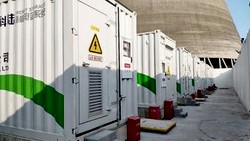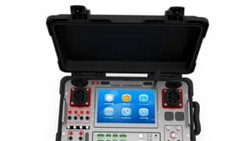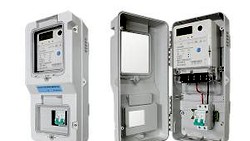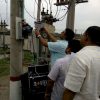This article covers only the testing aspects related to energy meters and enclosures. Sometimes you can find terms like "waterproof" or "dust-proof" in advertisements. This terms are not very clear.
Luckily in metering you have international standards for clarification. We focus here only on our relevant part of the IEC 60529. The article gives only an overview. For more details you need to study the root literature.
An IP rating contains two numbers (i.e. IP54) in most instances which related to the level of protection provided by an enclosure or energy meter housing. IP tests can refer to IEC standard 60529, it's European equivalent EN 60529, NEMA standards or others.
The ISO 17035 accredited type test laboratory of CLOU is able to perform ingress protection testing that satisfies NEMA, IEC 60529, EN 60529, MIL-STD 810, SAE and RTCA-DO-160 specifications.
First digit: Solid particle protection
The first digit indicates the level of protection that the enclosure provides against access to hazardous parts (e.g., electrical conductors, moving parts) and the ingress of solid foreign objects.
Most energy meters are rated with level 5 for dust protection.
| Level | Effective against | Description |
| X | — | No data available for dust protection |
| 0 | — | No protection against contact and ingress of objects |
| 1 | >50 mm | Any large surface of the body, such as the back of a hand, but no protection against deliberate contact with a body part |
| 2 | >12.5 mm | Fingers or similar objects |
| 3 | >2.5 mm | Tools, thick wires, etc. |
| 4 | >1 mm | Most wires, slender screws, large ants etc. |
| 5 | Dust protected | Ingress of dust is not entirely prevented, but it must not enter in sufficient quantity to interfere with the satisfactory operation of the equipment. |
| 6 | Dust tight | No ingress of dust; complete protection against contact (dust tight). A vacuum must be applied. Test duration of up to 8 hours based on air flow. |
Second digit: Liquid ingress protection
The second digit indicates the level of protection that the enclosure provides against harmful ingress of water.
There are energy meters in the market between level 1 and level 4 for water protection.
| Level | Protection against | Effective against | Details |
| X | — | No data available for water protection | — |
| 0 | None | — | — |
| 1 | Dripping water | Dripping water (vertically falling drops) shall have no harmful effect on the specimen when mounted in an upright position onto a turntable and rotated at 1 RPM. | Test duration: 10 minutes Water equivalent to 1 mm rainfall per minute |
| 2 | Dripping water when tilted at 15° | Vertically dripping water shall have no harmful effect when the enclosure is tilted at an angle of 15° from its normal position. A total of four positions are tested within two axes. | Test duration: 2.5 minutes for every direction of tilt (10 minutes total) Water equivalent to 3 mm rainfall per minute |
| 3 | Spraying water | Water falling as a spray at any angle up to 60° from the vertical shall have no harmful effect, utilizing either: a) an oscillating fixture, or b) A spray nozzle with a counterbalanced shield. Test a) is conducted for 5 minutes, then repeated with the specimen rotated horizontally by 90° for the second 5-minute test. Test b) is conducted (with shield in place) for 5 minutes minimum. | For a Spray Nozzle: Test duration: 1 minute per square meter for at least 5 minutes Water volume: 10 liters per minute Pressure: 50…150 kPa For an oscillating tube: Test duration: 10 minutes Water Volume: 0.07 l/min per hole |
| 4 | Splashing of water | Water splashing against the enclosure from any direction shall have no harmful effect, utilizing either: a) an oscillating fixture, or b) A spray nozzle with no shield. Test a) is conducted for 10 minutes. Test b) is conducted (without shield) for 5 minutes minimum. | Oscillating tube: Test duration: 10 minutes, or spray nozzle (same as IPX3 spray nozzle with the shield removed) |
| 5 | Water jets | Water projected by a nozzle (6.3 mm) against enclosure from any direction shall have no harmful effects. | Test duration: 1 minute per square meter for at least 3 minutes Water volume: 12.5 liters per minute Pressure: 30 kPa at distance of 3 m |
| 6 | Powerful water jets | Water projected in powerful jets (12.5 mm nozzle) against the enclosure from any direction shall have no harmful effects. | Test duration: 1 minute per square meter for at least 3 minutes Water volume: 100 liters per minute Pressure: 100 kPa at distance of 3 m |
| 7 | Immersion, up to 1 m depth | Ingress of water in harmful quantity shall not be possible when the enclosure is immersed in water under defined conditions of pressure and time (up to 1 m of submersion). | Test duration: 30 minutes – ref IEC 60529, table 8. Tested with the lowest point of the enclosure 1000 mm below the surface of the water, or the highest point 150 mm below the surface, whichever is deeper. |
Equivalent NEMA Ratings
NEMA (National Electrical Manufacturers Association) ratings can be approximately compared to those of the IP system as shown below. Other factors such as corrosion protection are also involved in the NEMA system. Please refer to official documentation for details.
| NEMA | IEC 60529 |
| NEMA 1 | IP10 |
| NEMA 2 | IP11 |
| NEMA 12 | IP52 |
| NEMA 3 NEMA 13 | IP54 |
| NEMA 4 | IP56 |
How to test the Ingress Protection compliance with IP54 in detail
IP54 is the most used term in energy meter- and enclosure descriptions. The test consists of two parts.
Test for dust protection IP5X
The meter or enclosure is fixed in upright position in a dust chamber. Wires are attached to the meter. If the meter is wall mounted, it is fixed in the chamber in the same way.
The dust chamber is filled with 2 kg talcum powder per m3 chamber volume. Meters are typically tested without under-pressure (category 2). The duration of the test is 8 hours. During that time period the talcum powder is permanently ventilated inside of the chamber.
Once the test is finished you take your face mask. I suppose since COVID-19 everyone has one. Here it's used to protect you against inhalation of the talcum powder. The meter is cleaned from the dust with a brush. Then you remove the device for examination in the same position like it was fixed inside the chamber.
Pass/Fail criteria
Here the IEC standard leaves some space for interpretation. The original wording:
The protection is satisfactory if, on inspection, talcum powder has not accumulated in a quantity or location such that, as with any other kind of dust, it could interfere with the correct operation of the equipment or impair safety.
So, you open the meter and make a visual inspection. If there is powder inside, you will see the trails. Now it's up to you to decide whether this trails can be harmful or not.
In many cases the estimation is subjective, so we rely for this test on a 3rd party certificate from another international accredited laboratory.
Test for water protection IPX4
For this test you need to have a chamber or a setup with an oscillating tube. There is also the possibility to use a spray nozzle, but this is not covered here.
The oscillating tube has spray holes over the whole 180″ of the semicircle. The total flow
The oscillating tube has spray holes over the whole 180″ of the semicircle. The total flow rate is adjusted as specified in the standard and is measured with a flow meter. The tube is oscillating trough an angle of almost 360° (+/- 180° from the top).
The test duration is 10 minutes.
Once the test is finished you dry the outer surface with some cotton or household tissue. Then you can start the examination. Some water on the bottom of the terminal cover is normal, as the terminal cover is not a part of the meter housing.
Open the meter careful und check.
Again the original IEC wording:
It is the responsibility of the relevant technical committee to specify the amount of water which may be allowed to enter the enclosure and the details of a dielectric strength test, if any.
Also for this test we rely for this test on a 3rd party certificate from another international accredited laboratory to confirm our evaluation.
Conclusion
In many regions of the world the energy meters are installed outdoor. They are exposed to various climatic– and weather conditions. You can face heavy storms and a significant amount of rain.
When you have ever seen the rain in tropical areas you know that the quantity of water is dramatically exceeding the given test conditions of IPX4. The rain will also not stop after 10 minutes.
Best praxis for outdoor installation of energy meters is to put them into an enclosure.
Beside of the additional protection layer against dust and water the enclosure offers a protection against fraud and tamper.
It's more difficult to access to the terminals and opening of the enclosure door can initiate an alarm for your AMI system.
Thank you for reading. Stay safe and if you have related questions don't hesitate to contact us. Or leave us a comment in the section below.
Editor's note: This article was originally published in May 2020 and has been updated for comprehensiveness.






All comments are moderated before being published. Inappropriate or off-topic comments may not be approved.